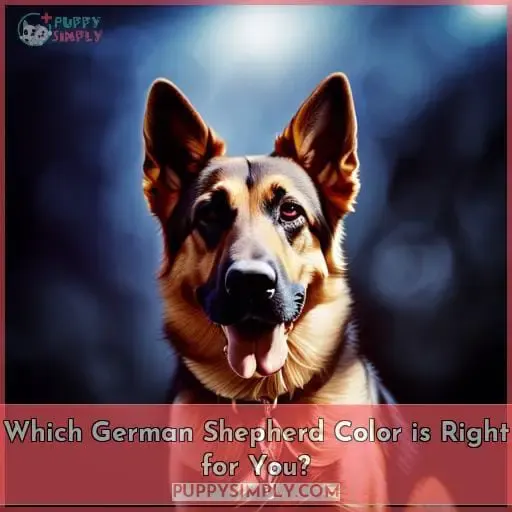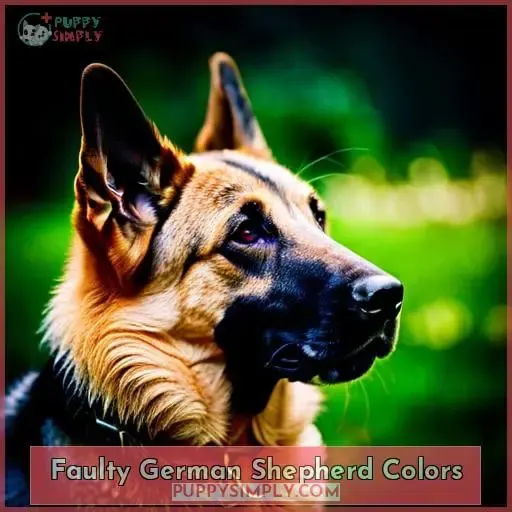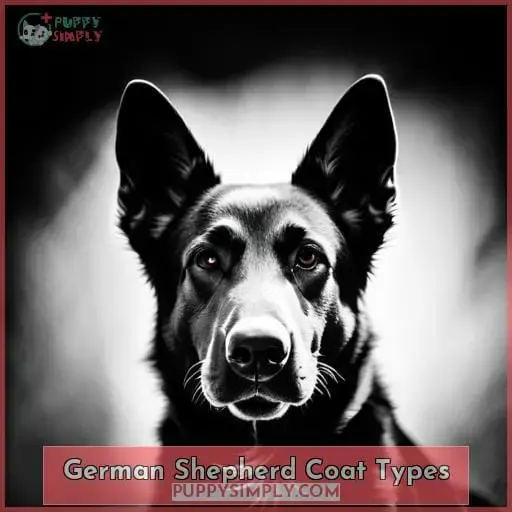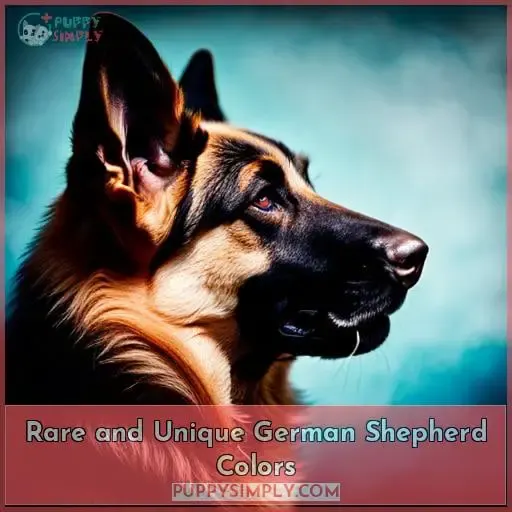This site is supported by our readers. We may earn a commission, at no cost to you, if you purchase through links.
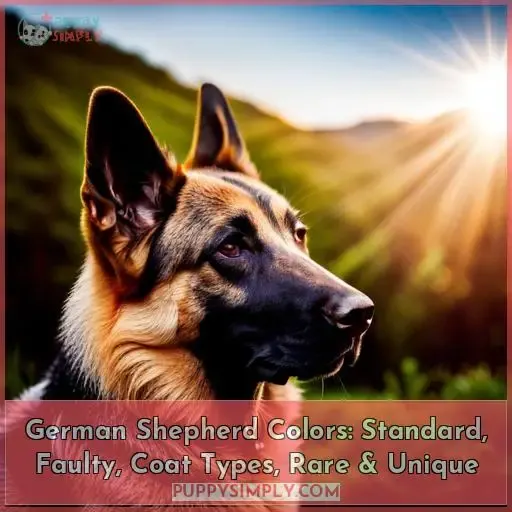 Are you looking for a loyal companion with intelligence and grace? Look no further than the German Shepherd! Not only do they possess all these qualities, but they also come in a variety of stunning colors that will add an extra spark to your life.
Are you looking for a loyal companion with intelligence and grace? Look no further than the German Shepherd! Not only do they possess all these qualities, but they also come in a variety of stunning colors that will add an extra spark to your life.
From traditional black & tan to more rare shades like liver and blue, there’s sure to be one that catches your eye.
So if you’re interested in finding out about all the wonderful German Shepherd colors available, read on for our comprehensive guide!
Table Of Contents
Key Takeaways
- Classic colors for German Shepherds include black & tan, sable, bicolor, and black.
- Less common colors for German Shepherds include panda, liver, black and silver, blue and tan, and white sable.
- Controversial colors for German Shepherds include white, pure white, solid gray, and solid red.
- When choosing a German Shepherd color, consider factors like lifestyle, environment, and personal preference.
Standard Colors of German Shepherds
When it comes to German Shepherds, the standard colors include Black and Tan, Sable, Bicolor, and Black and White. These unique colors come in various shades of their respective base color and create a stunning look for the active breed.
Black & Tan
Get the classic black and tan look with a German Shepherd – perfect for working-line dogs! The variations in shades of black and tan can range from light to dark. Genetics play an important role in determining the coloration of this breed, as certain genes are responsible for producing these colors.
While sable is popular among show lines, many prefer the traditional black & tan coat combination due to its striking appearance when groomed properly. Working line GSDs typically feature an even distribution of both colors across their body, while show standards may require more pronounced differences between their hues.
With proper care and nutrition, you’ll be able to maintain your pup’s stunning coloring well into adulthood!
Sable
You’ll love the sable pattern, which features black peppered across your pup’s fur. This is one of the most popular German Shepherd colors and has several variations such as black sable or gray sable. It’s a deep crimson color that results from recessive traits in genetics, making it easier to predict when breeding for this shade.
When caring for your pup’s coat with this pattern, regular brushing and occasional baths will help reduce shedding and maintain its rich coloring over time.
Bicolor
Experience the contrast of black and tan on a bicolor German Shepherd for an eye-catching look. Considerations include genetics, coat traits, temperament traits, and more when choosing this color pattern.
Bicolor vs sable is distinguished by its even coloring with shades from light gray to red/brown; whereas bicolors have dominant black with lighter colors mainly on legs or chest. Genetics are harder to predict since multiple genes may affect the outcome of puppies.
As far as coat traits go, expect dark fur with variations in shades between silver/gray/cream along with occasional white patches that could disqualify them from shows.
When it comes to temperament, they’re no different than other varieties – so their behavior should be based on upbringing rather than color alone!
Black
Discover the classic black German Shepherd, popular among working-line dogs and excellent guard dogs. Its coat is a solid black with variations in shades of grey and silver, as well as white patches. Health concerns may arise from its rarer bi-color coats, but overall, this breed’s health is largely unaffected by coloration.
Breeding considerations should take into account faulty patterns such as Wolf Mask or Panda for show eligibility while still maintaining good health standards. Historically used mainly to herd sheep in Europe, most often sable-colored Shepherds were seen.
White
Behold the rare beauty of a White German Shepherd, characterized by its exotic look and shimmering blue-gray coat. It faces controversy in dog shows due to its genetics, yet remains an attractive choice for families seeking a loyal companion.
Its unique traits include the white coloration, potential genetic health issues, disqualification from shows, and amber eyes with darker patches around them.
If considering one as a pet, prioritize health over appearance to avoid any potential serious faults or illness associated with this beautiful breed.
Which German Shepherd Color is Right for You?
When selecting the perfect German Shepherd for your family, it is important to consider factors such as lifestyle, environment, and personal preference. With so many different colors available, from black and tan to blue or white, there are a variety of options that can fit any home.
Factors to Consider
When choosing the perfect German Shepherd companion, consider factors like health, temperament, and color – all of which can be as different from each other as night and day.
Additionally, you must take into account personal preferences such as coat colors that fit with your lifestyle or aesthetic needs. Color variations range from standard black & tan to rarer shades of white and Isabella (lilac).
Consider how these unique hues may impact their eligibility in breed shows or breeding programs before making your decision.
Finally, it’s important to remember that no single color indicates health benefits or superior ability – so choose wisely!
Personal Preference
No matter your preference, there’s a German Shepherd color that’s perfect for you! From solid black to bi-color and sable, or the rare Isabella (lilac) coat, it all comes down to personal choice.
Consider breed suitability and visual harmony when selecting a color. Opt for black & tan if you’re looking for working-line dogs or black & red show lines. Silver is visually appealing with its wolf-like appearance while cream provides families with an excellent companion pet.
Rare colors like blue have special traits but can be expensive; liver has shades of dark brown often paired with amber eyes; white is exotic yet disqualified in shows due to health concerns; gray carries multi-functionality as both family pets and guard dogs alike – all of which should be considered before making any decision!
Lifestyle and Environment
Consider your lifestyle and environment when choosing the perfect German Shepherd for you. Do you have a large backyard for them to run around in, or is apartment living more your style? Also, take color preference into account.
If double coat maintenance isn’t ideal, opt for an all black or sable coat variation instead of traditional black & tan. Remember to keep up on brushing during shedding season, as it can become overwhelming with German Shepherds.
Furthermore, breeding controversy may come into play if rare colors like white are preferred. White German Shepherds face disqualification from dog shows and potential health issues. Ultimately, prioritize temperament and health over color when selecting a pup. No single color indicates any specific traits other than environmental adaptation.
Faulty German Shepherd Colors
When looking for the perfect German Shepherd, it’s important to understand that not all colors are acceptable in the show ring. Solid White, Gray, Blue, or Red, as well as Fawn/Isabella coats, can be disqualified from competition due to their deviation from breed standard.
Knowing these faulty colorations is fundamental when deciding what type of pup you’d like in your home.
Pure White
Pure white German Shepherds make for an exotic look but are disqualified from participating in dog shows. Their coat characteristics include a solid bright white color with no other colors or markings, making them stand out among the AKC standard colors of black and tan, sable, and bicolor.
White coats can be due to albinism in dogs, which may result in some health considerations, including vision impairment. Breeding controversy exists as well since it is difficult to predict the genetic makeup that will produce a pure white puppy, even if both parents have this trait.
White markings on otherwise standard-colored GSDs are acceptable for show events but should be monitored closely due to their potential effect on eligibility.
Solid Gray
Solid Gray German Shepherds are known for their deep gray coat and multifunctional nature, making them popular pets for active families. The solid color arises from the merle gene, though this can sometimes lead to health considerations.
Variations of gray range from light silver to charcoal black – all without markings or patterns.
With proper care and attention, a Solid Gray German Shepherd can make an excellent companion with unique looks that stand out in a crowd!
Blue
Breathtaking blues, from a blue-gray shimmer to rare lilac hues, are hard to come by in German Shepherds. Blue coats are caused by two recessive genes, making them difficult to predict. Though they may be considered controversial for shows and breeding purposes due to their rarity and potential health issues, many still find them attractive companions with an exotic look.
Despite this uniqueness, no single color can assure good temperament or skills. All of these factors depend on genetics and upbringing! Golden Germans have recently become popular as well. These combine the traditional black & tan coat with golden highlights that add a touch of glamour without compromising health standards.
Ultimately, it is essential for prospective owners to prioritize health over color when choosing their pup, regardless of whether it’s blue or golden!
Solid Red
The striking Solid Red German Shepherd is a deep mahogany color with black patches, making it an eye-catching and regal breed. This coat variation has the potential to be disqualified from shows due to its genetics stemming from Isabella or blue parents.
Health considerations should always take priority when selecting this type of GSD since it can come with recessive traits that carry certain risks. Breeding challenges can exist as well since Solid Reds are difficult to predict genetically despite their popularity in families looking for loyal companionship.
But regardless of these issues, they remain beloved members of many households around the world!
Fawn/Isabella
Fawn and Isabella German Shepherds boast a rare lilac hue, perfect for those looking to make an exotic statement. Both colors are variations of the sable pattern but may be disqualified in shows due to genetic health risks.
Breeding considerations should always prioritize health over coloration, as some hues can come with potential issues.
Despite myths about temperamental differences between coat colors, all German Shepherds respond equally well to training and socialization from puppyhood onward.
German Shepherd Coat Types
German Shepherds are known for their thick, double coat that can come in four distinct types: the long coat, plush coat, wire coat, and double coat. Each of these coats has its own unique characteristics and qualities that make it a favorite among dog lovers.
Double Coat
You may be familiar with the double coat of a German Shepherd, which consists of an outer layer (guard hairs) and inner layer (down hairs). Its soft undercoat provides insulation from cold temperatures, while its guard hair protects against wet weather.
Double coats also provide shedding protection, as they shed less often than single-coated breeds.
Proper care is needed to keep your dog’s coat healthy. Regular brushing will remove mats and dirt buildup from their fur and can reduce unwanted shedding. Grooming helps keep the skin underneath clean while maintaining a glossy look on your pet’s topcoat.
A well-groomed German Shepherd makes for an excellent guard dog due to their coloration that blends in easily with surroundings or alerts owners when something isn’t quite right!
Long Coat
Experience the beauty of a long coat German Shepherd, with its luxurious fur and regal appearance. The most common color is black and tan, but you can also find sable, bicolor, liver, or even rarer colors like blue or white.
Long coats often have unique patterns such as saddle markings on their back or brindle stripes across their body.
Shedding solutions are available for those who struggle with excessive shedding too, which can help reduce hair all over your home.
Plush Coat
The plush coat of a German Shepherd is characterized by its long, thick fur that gives it a soft, velvety texture. Its glossy sheen and elegant appearance make it popular among owners who prioritize looks over utility.
There are both pros and cons to having this type of coat. Grooming can be demanding but may come with additional health benefits for the dog. Plush Coated Shepherds typically have fuller cheeks than other varieties due to their longer hair on the face.
This also includes an eye-catching mask pattern around the eyes when seen in profile view.
When caring for this type of breed, brushing regularly is essential to remove dirt and debris from its dense outercoat.
Although often compared with other types such as Long Coat or Double Coat GSDs, there’s no doubt Plush Coats excel in beauty alone.
Wire Coat
Discover the unique look of a Wire Coat German Shepherd, boasting an impressive 90% reduction in shedding with just one brush! These dogs have a dense double coat that is short on the body and longer around their neck.
The texture ranges from coarse to wiry and comes in several variations, including long-haired, rough-haired, and medium-coated.
They come in special colors like sable, black & tan, gray, or liver – all with distinct wire patterns throughout. With regular care, they will remain healthy, but grooming must be done regularly due to oil buildup leading to skin irritations or infections if left unchecked.
Regular brushing helps reduce matting while removing dirt, as well as dead hair, which allows for healthier regrowth of their coats over time – something other breeds cannot achieve through any amount of brushing alone! Wire Coats hold various advantages compared to other types, such as increased protection against extreme temperatures, making them ideal pets even during winter months without needing extra layers of clothing or blankets added on top – perfect for those who want convenience combined with good looks!
Rare and Unique German Shepherd Colors
Are you considering a unique German Shepherd? Many rare and beautiful colors can be found in this breed, including Panda, Liver, Black and Silver, Blue and Tan, and White Sable.
Panda
You’ll be amazed by the Panda pattern, with black markings around the eyes that give it a unique look. This rare coat type is characterized by dark patches around the eyes and ears, as well as white sable traits like tan or gray fur on its body.
It’s important to note that this color variation isn’t recognized in most shows due to conformation faults and should only be considered if health is your top priority.
Other variations of German Shepherds include rare liver colorings, blue and tan variations, and standard colors such as black & silver coats or bi-colors with dominant blacks.
No matter what coat type you choose for your pup, always prioritize their health over appearance!
Liver
Admire the dark brown, highly sought-after liver color of German Shepherds – a hue that gleams like polished mahogany. This rare and striking coat can range from deep chocolate to light amber shades, often paired with golden eyes.
Its recessive genes make it challenging to predict when breeding or exhibiting dogs. Careful consideration should be taken when deciding between livers and black German Shepherds as they may have different genetic health issues associated with them.
Liver coats also require increased upkeep compared to their black counterparts due to their higher propensity for dirt accumulation in fur; however, proper grooming will help maintain the good condition and shine of this majestic coloration!
Black and Silver
Behold the striking Black and Silver German Shepherd, an exotic look with a silver base and black accents that creates a wolf-like appearance. This rare coloration is highly sought after for its beauty yet remains uncommon in show rings due to disqualification.
The Black and Silver coat shimmers like moonlight as it catches the light, offering your pup a regal air when they take on their daily activities.
Its Wolf Appearance brings confidence while still being a loyal companion for all kinds of adventures or simply cuddles at home!
Blue and Tan
Experience the majestic beauty of blue and tan German Shepherds, with their striking coats that shimmer like a night sky! Blue and Tan is an extremely rare color for this breed.
Its coat has distinct shades of blue-gray over its traditional tan markings. This controversial color often faces disqualification in dog shows due to genetics health issues associated with it; however, many believe this distinctive appearance should be celebrated instead!
- Genetics: Blue is caused by two recessive alleles which can lead to genetic health risks if not bred responsibly.
- Appearance: A unique combination of classic black & tan but appearing more silver or grayish than black on some areas such as legs & face masking area
- Controversy: While beautiful, there are debates around whether the blue variation should be accepted into conformation competition standards or not due to potential genetic health issues associated with these colors being present in certain bloodlines/lineages
- Isabella vs Blue: Isabella (Lilac) is considered even rarer than the traditional ‘blue’ resulting from three different gene variations combined together – although both carry similar tones they appear very different upon closer inspection. The perfect example will display white tipped hairs all throughout its coat adding a slightly lighter shade compared to just plain blues ones
White Sable
Gaze upon the rare white sable pattern, featuring a silver base with black markings on top. This variation of the traditional Sable German Shepherd is highly sought after for its striking appearance and unique characteristics.
The genetics behind producing this coloration are quite complex as it involves recessive traits from both parents to create such a stunning coat combination. When compared to standard sables, white sables may appear lighter in color but boast similar genetic qualities that make them stand out among other colors within the breed.
These gorgeous dogs are known for their glossy coats which can range from beige and gray hues all blended together into one beautiful look! With proper care and maintenance, these majestic creatures will remain healthy while showing off their amazing coat patterns proudly!
Conclusion
Choosing the right German Shepherd color for you can be a daunting task. With so many options available, it’s important to take into account your lifestyle, environment, and personal preference.
Standard colors like black & tan and sable are popular, while faulty colors like pure white, solid gray, and solid red are disqualified from shows. There are also unique and rare colors like panda, liver, and white sable to consider.
Ultimately, while color can be a fun factor, it should not be your only consideration when selecting a German Shepherd. With so many beautiful and unique variations in their coloring, German Shepherds truly are one of the most majestic breeds.
So, make sure to choose the one that fits your lifestyle and personality the best.


